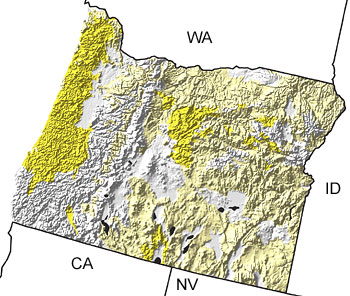Paleontology and geologyDuring the early Tertiary, Oregon was warm and humid. Fossil turret shells, fig shells, and cockles indicate that the marine waters off the coast were warm. Rainforests grew along the coast with wet forests extending farther inland. Hyaenadonts, early cats, and other predators fed on large hoofed mammals, such as brontotheres and amynodonts. By the middle Tertiary, conditions were cooler and drier. Clams, snails, and other marine organisms similar to modern species inhabited the waters off Oregonís coast, and forests of oak and alder covered the landscape. Horses, camels, deer, bears, weasels, dogs, and cats, as well as larger mammals like the gomphotheres (early elephants), rhinoceroses and bear-dogs wandered the landscape. Tectonic activity during the Tertiary caused the uplift of the Coast Range and the Cascades in central Oregon. |


